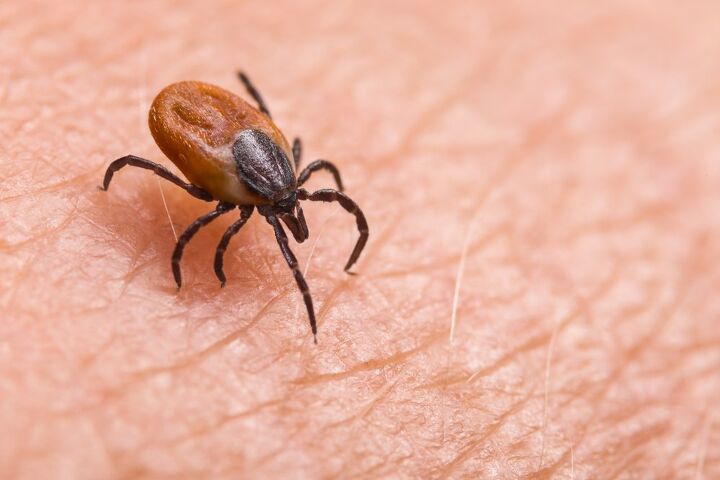Can You Flush A Tick Down The Toilet? (Find Out Now!)

Dealing with even one tick can be a big pain. Removing the tick can be frustrating enough, but once that part is over, you may be wondering how best to kill it and get rid of it. One of the most obvious options that may pop in your head is flushing it down the toilet. But can you?
The short answer is yes, you can flush a dead or live tick down the toilet. The longer answer is ticks do not drown easily, so simply dropping the tick in the toilet will not kill it. Once flushing it, make sure it goes fully down the drain. Otherwise, you risk it crawling back out of the bowl.
Just because you can flush a tick down the toilet doesn’t mean you always should. Let’s learn a bit more about it, so you know how best to dispose of a tick found in your home.
Do You Need Pest Control Services?
Get free, zero-commitment quotes from pro contractors near you.

Why You Should Flush a Tick
Flushing a tick down the toilet is usually a useful way to get rid of it, but it’s important to do it correctly. First and foremost, remember that simply dropping a tick in the toilet won’t be enough. Be sure to flush a couple of times to ensure it went all the way down the drain.
You’re even better off if the tick is already dead as you won’t have to worry about it not drowning. Either way, you will not experience any issues with your toilet itself as ticks are very small.
And Why You Should Not Flush a Tick
Instead of disposing of the tick, it may be smarter to hold on to the dead insect in case you, your family member, or your pet that had the tick on them develops unusual symptoms. By having the tick still, you can send it in to get tested for pathogens and figure out what has infected you.
Some common symptoms that you may begin to develop after removing a tick include rashes, body aches, joint pain, and fever. Your treatment will depend on your symptoms and the geographic area where you were bitten as different types of ticks are more common in different states. If you have the tick handy, it can help this process along even more.
Types of Ticks
Ticks are a type of arachnid that have oval bodies that swell when they feed. Their food source is the blood of all types of animals, including humans. They are one of the most dangerous spreaders of diseases, second only to mosquitoes. There are a variety of different types of ticks, but all can be classified under these two categories.
Hard Ticks
Hard ticks have a plate on their back and visible mouthparts when seen from above. They often search for food during the daytime and thrive in wooded areas and moist wetlands that are home to many mammals.
These types of ticks transmit far more diseases throughout the United States than soft ticks because they are more likely to feed on both humans and animals instead of just one or the other. They most commonly spread the following diseases:
- American babesiosis
- Anaplasmosis
- Colorado tick fever
- Human tick-borne ehrlichiosis
- Lyme disease
- Rocky Mountain spotted fever
- Southern tick-associated rash illness (STARI)
- Tick paralysis
- Tularemia
…and more.
Soft Ticks
Soft ticks appear to have a more wrinkled body as they lack that plate along their back. Their mouthparts are on their underside, so you can’t see them from above. They most often hunt for a food source at night.
Unlike hard ticks, soft ticks are better suited for hot and dry conditions and can be found in animal dens, caves, cabins, and sheds. These types of ticks often only spread tick-borne relapsing fever in comparison to the long list of issues hard ticks can cause.
Additional Considerations
Never Crush a Tick with Your Fingers
Ticks are small, so your initial reaction may be to smash it between your fingers once it has been removed. However, this is not a good idea because you can accidentally expose yourself to pathogens if it is infected.
Other Methods of Killing
The best way to make sure a tick is actually dead is to either suffocate it in a plastic bag or jar or burn it in a controlled space. Submerging the tick in alcohol is another effective way to kill it, and it makes it easier to hold on to the body should you need to have it tested in the future.
How Not to Kill Ticks
There are many effective ways to kill a tick, but here are a couple things you definitely should not do. If you still have a tick stuck in your skin, do not try to smother or burn it.
Both of these methods can cause the tick to release fluid, which can get into your open wound and cause an infection. Plus, you could end up burning yourself.
Do You Need Pest Control Services?
Get free, zero-commitment quotes from pro contractors near you.

Related Questions
Can ticks survive in the washing machine?
Yes, ticks are able to survive even a hot-water rinse cycle in your washing machine. However, a quick 10 minutes in the dryer should kill them right away. Ticks need moisture to survive, so the dryness will get rid of them quickly.
What can climb up the toilet drain?
Though ticks can’t swim, there are plenty of creatures that can find their way up the sewer pipes and into your toilet. These include amphibians like frogs, lizards, snakes, and some mammals like rats and squirrels.
Final Thoughts
Technically, you can flush a tick down the toilet, but it may not actually kill it. While ticks cannot swim, many types can survive underwater for two to three days, so simply drowning them is not a likely outcome. That said, flushing a tick is guaranteed to at least get it away from your home, even if it won’t kill it outright.

I am a copywriter and editor based in the Las Vegas area with nearly a decade of experience under my belt writing landing pages, cost guides, blog posts, newsletters, case studies, and social media content. I have a degree in Strategic Communication and experience working in both the account and creative spheres. My goal is to always be discovering new interests and bettering myself as a writer and editor along the way.
More by Kerry Souder



























